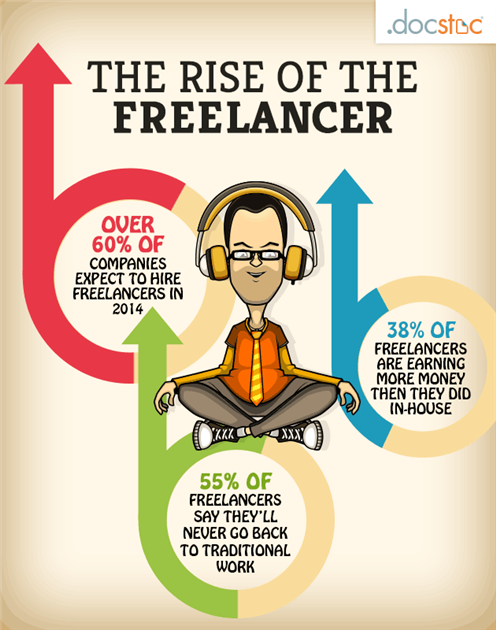We already know that the freelancing sector is big business. They’ve got their own ‘day’, after all. National Freelancers’ Day is celebrated by millions of independent professionals across the globe, paying homage to those who enjoy the freedom and flexibility that comes with captaining their own ship.
The freelancing market is growing, and it’s growing fast. Take a look at the following article from docstoc.com. Research by Accenture suggests that between 20% and 33% of the U.S. workforce is made up of freelancers and independent contractors, compared to just 6% in 1989.
Further research suggests that over 60% of U.S. companies plan on hiring freelancers in 2014, while about 20% of global companies have outsourced or offshore workers.
No wonder it’s described as a revolution.
All these hardworking independents need somewhere to land. Of course, this offers a prime opportunity for the business centre and coworking industries. Even those freelancers who have a perfectly good desk at home need to get out now and again, to meet clients, network, visit suppliers, or escape the loneliness of working at home alone.
Flick back over the OT archives and you’ll see upward trends in mobile working, growth in dispersed teams, more flexible contracts and of course, a freelancing boom. A desire for greater flexibility and the ability to work without walls thanks to advanced mobile technology means these markets have room to grow. And they’re certainly doing that.
Read docstoc.com’s review in full below and let us know what you think. It will help you to understand this market a little more – their wants, needs, and what drives them. You should take the time to get to know them because if this trend continues, these independents could be filling up your coworking spaces and serviced offices by the dozen in years to come, and then some. Are you ready to welcome them in?
———————————-
Declaring Independence: The Freelance Revolution
By: Docstoc Articles
Tuesday, February 18, 2014
There’s a new breed of American worker that’s poised to take over the marketplace. Empowered and independent, this new breed is also a hybrid entrepreneur, one who controls his or her own schedule, lands clients and maintains an office space. On top of that, these entrepreneurs rake in more cash than traditional, in-house employees. Who can blame them for wanting to break away from the cubicle to start their own ventures?
Who is this emerging worker? The Freelancer.

The Freelance Market at a Glance
Although freelancers and independent contractors have existed for countless generations, the rise of cloud computing has made doing independent work from home that much simpler.
A recent study conducted by Accenture estimates that between 20 and 33% of the U.S. workforce is made up of freelancers and independent contractors.
To put this in perspective, in 1989, independent workers comprised only 6% of the workforce; that means the market share for freelancers has increased at least three-fold in just over two decades.
And this trend is showing no signs of slowing down. Another study conducted by Tower Lane and Elance found that over 60% of U.S. companies plan on hiring freelancers in 2014.
Accenture also found that some industries (like the oil and gas industries) have as much as 77% of their workforce residing outside the core organization, while about 20% of global companies have outsourced or offshore workers.
Benefits of Freelance Work
Benefits abound for independent workers. An industry report conducted by the International Freelancers Academy (IFA) found that 38% of the survey’s respondents earn more money as a freelancer than they did as in-house employees. In fact, about 15% of the freelancers surveyed reported earning at least $100 an hour. But the perks of freelancing don’t stop there.
Not surprisingly, most freelancers (46%) say they have more free time than they did when working as traditional in-house workers; in comparison, only about a quarter (27%) of respondents say they have less free time as a freelancer.
What is surprising, however, is that just over half the respondents (57%) say they feel more secure as a freelancer than they did as a full-time employee, despite the fact that jobs are often temporary and can be tough to land. In addition to that, 70% say they are happier as a freelancer, and 79% say they’re more productive. In perhaps the most telling stat of all, a full 55% say there’s “no way” they’ll go back to traditional work.
So what exactly keeps the workers happy?
Elance asked the respondents to list the best aspects of being a freelancer, and atop the list were:
- Controlling their own schedule
- Being their own boss
- Following their passions
- Not commuting
- Having more choice over work projects
Pitfalls of Freelance Work
Freelancing isn’t best for all people. When asked what the biggest challenges were for freelancers, the top responses were:
- Finding clients
- Feast-or-famine work cycle
- Maintaining work/life balance
- Managing time and staying productive
- Earning better rates
When considering doing freelance work, keep in mind that it’s often solely your responsibility to find, vet and land clients, which in itself can be a very time-consuming and frustrating prospect. A headhunter or employment agency can help alleviate these tasks, but these services can often be expensive and can dip into your earnings. Be prepared to hustle for some time while finding clients before reaping the benefits of a flexible freelance schedule.
Also, keep in mind that not all professions benefit monetarily from freelance work. While many positions earn more cash through freelance than in-house work, some jobs generate weaker wages, including:
- IT systems support (53.8% make less than they did as a traditional worker)
- Marketing professional (44.1%)
- Editor/copy editor (41.7%)
- Designer (40.3%)
- Software developer (35.7%)
Deciding to become a freelancer is a huge professional decision. For those of you in large cities with many job prospects, perhaps it’s in your best interest to stay at a traditional position. Before making the commitment to freelance work, research industry practices to gauge where your wages might fall, and weigh all factors, including pay, commute, personal time, insurance costs, etc.
Sources
Accenture: “Trends Reshaping the Future of HR: The Rise of the Extended Workforce”
Tower Lane and Elance: “Surveying the New World of Work”
International Freelancers Academy: “Freelance Industry Report”
Elance: “The State of the Freelance Market”


 Dr. Gleb Tsipursky – The Office Whisperer
Dr. Gleb Tsipursky – The Office Whisperer Nirit Cohen – WorkFutures
Nirit Cohen – WorkFutures Angela Howard – Culture Expert
Angela Howard – Culture Expert Drew Jones – Design & Innovation
Drew Jones – Design & Innovation Jonathan Price – CRE & Flex Expert
Jonathan Price – CRE & Flex Expert














